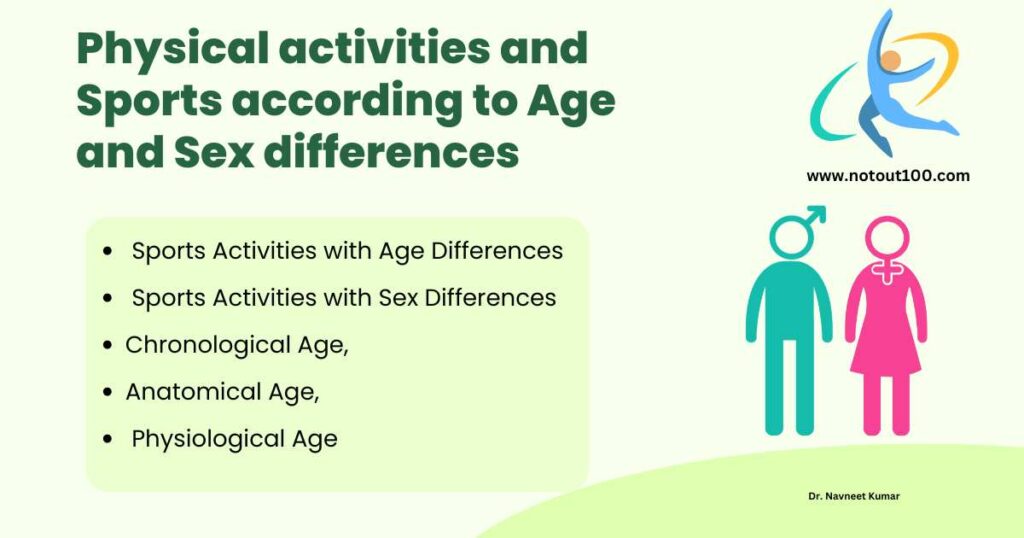
Physical activities and Sports according to Age and Sex differences
Both boys and girls enjoy playing games. However, girls tend to prefer playing in groups. While boys experience a sense of excitement during games, girls experience a sense of endurance. Boys generally possess greater physical strength, as they are trained to develop into a masculine form. In contrast, the structure and functions of girls’ bodies are distinct.
1. Physical Structure
Boys are generally taller and heavier than girls, a difference observable even at birth. At birth, a boy is typically larger than a girl. From the onset of puberty, girls experience gradual development, whereas boys continue to grow and increase in height and weight until the age of 25. In light of these differences, it is essential to teach children diverse physical activities.
• The body size of girls is typically smaller compared to boys. The body parts of girls are narrower and more delicate, requiring them to engage in less vigorous physical activities.
• The bodies of girls are lighter, with thinner limbs compared to boys. • Due to their smaller body parts, girls are not as physically capable as boys. • Girls possess a narrower trunk and longer legs.
• The pelvic structure of girls is broader compared to boys, as nature has designed it to support childbearing and caregiving. • The joints in girls are more flexible than in boys.
• The shoulders of girls are broad and rounded, whereas those of boys are narrower.
2. Physical Activities •
Muscular Strength: Girls have weaker muscles compared to boys. In boys, the muscle tissue is stronger, enabling them to grasp, pull, and push objects with greater force. As a result, girls find it more challenging to perform physically demanding tasks.
• Blood Circulation: The size of girls’ hearts is smaller, which affects the efficiency of blood circulation to different parts of the body.
• Respiratory System: The lungs of girls are smaller in comparison to those of boys, causing them to tire quickly during physical activities.
• Menstrual Cycle: This cycle occurs approximately once every four to five weeks. During this period, doctors advise against strenuous exercise, although research has indicated that engaging in light exercise and yoga can improve their well-being.
• Childbirth: This function is unique to girls, as they have the capacity to bear children.
Chronological Age, Anatomical Age, Physiological Age
- chronological age.
The duration of “from birth to present or death” is a real measure of chronological age. We calculate a child’s age from birth based on chronological age criteria. This age encompasses several stages.
Infant Stage:
This age lasts only one year. In this stage, the child learns to hold its head up, sit, crawl, and walk. Children are active and make attempts to grasp objects with their hands.
Childhood Stage:
This age spans from one to six years. During this time, the child spends most of the time playing and engaging in physical activities. In this phase, the child learns to walk steadily and forms companionship with peers. They become interested in doing every task independently.
Adolescent Stage:
This stage ranges from nine to sixteen years. During this age, the emphasis on academic learning increases. Children prefer doing tasks independently. It is an optimal time to teach children to play as their bodies are growing and developing.
Youth Stage:
This age begins at eighteen years. Children undergo mental development based on their experiences. This is the most appropriate time for excellent performance in sports competitions. In this age group, individuals understand the implications of every task.
This stage is divided into three parts, thus emphasizing indoor sports. Therefore, from birth to death, various stages measure physical development based on chronological age. For example, if a child is five years old, their development can be assessed based on age-related criteria.
This stage mainly sees bone expansion. To measure it, X-rays are used. Knowledge of this age is also gained through the teeth, which emerge in childhood and later become permanent. Teeth count can determine age. Similarly, a newborn has about 300 bones, but some fuse later.
The body eventually has 206 bones. Small children should not be subjected to strenuous and rigorous exercise, as it could affect their growth. An instructor should provide appropriate and regular activity for children.
Physical activities and monthly rituals known as ‘Samvatsar’ begin at 40-50 years, indicating the onset of visual difficulties. This age group may develop wrinkles and lines on the face. At fifty to sixty years, vision problems often arise, causing rapid decline.
Severe physical issues and the need for medical interventions occur between seventy and ninety years. Thus, from childhood to old age, the human body undergoes various types of changes.